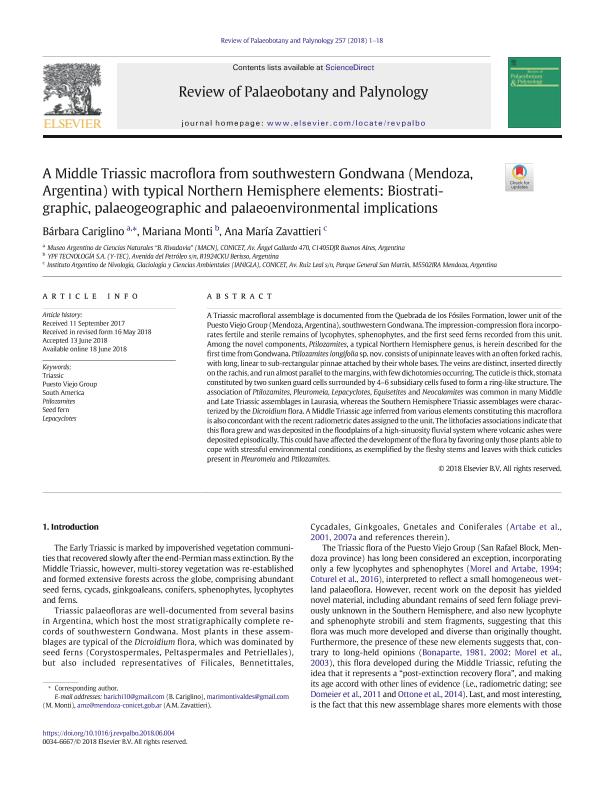Mostrar el registro sencillo del ítem
dc.contributor.author
Cariglino, Barbara

dc.contributor.author
Monti, Mariana

dc.contributor.author
Zavattieri, Ana Maria

dc.date.available
2019-10-25T20:29:33Z
dc.date.issued
2018-10
dc.identifier.citation
Cariglino, Barbara; Monti, Mariana; Zavattieri, Ana Maria; A Middle Triassic macroflora from southwestern Gondwana (Mendoza, Argentina) with typical Northern Hemisphere elements: Biostratigraphic, palaeogeographic and palaeoenvironmental implications; Elsevier Science; Review of Palaeobotany and Palynology; 257; 10-2018; 1-18
dc.identifier.issn
0034-6667
dc.identifier.uri
http://hdl.handle.net/11336/87308
dc.description.abstract
A Triassic macrofloral assemblage is documented from the Quebrada de los Fósiles Formation, lower unit of the Puesto Viejo Group (Mendoza, Argentina), southwestern Gondwana. The impression-compression flora incorporates fertile and sterile remains of lycophytes, sphenophytes, and the first seed ferns recorded from this unit. Among the novel components, Ptilozamites, a typical Northern Hemisphere genus, is herein described for the first time from Gondwana. Ptilozamites longifolia sp. nov. consists of unipinnate leaves with an often forked rachis, with long, linear to sub-rectangular pinnae attached by their whole bases. The veins are distinct, inserted directly on the rachis, and run almost parallel to the margins, with few dichotomies occurring. The cuticle is thick, stomata constituted by two sunken guard cells surrounded by 4–6 subsidiary cells fused to form a ring-like structure. The association of Ptilozamites, Pleuromeia, Lepacyclotes, Equisetites and Neocalamites was common in many Middle and Late Triassic assemblages in Laurasia, whereas the Southern Hemisphere Triassic assemblages were characterized by the Dicroidium flora. A Middle Triassic age inferred from various elements constituting this macroflora is also concordant with the recent radiometric dates assigned to the unit. The lithofacies associations indicate that this flora grew and was deposited in the floodplains of a high-sinuosity fluvial system where volcanic ashes were deposited episodically. This could have affected the development of the flora by favoring only those plants able to cope with stressful environmental conditions, as exemplified by the fleshy stems and leaves with thick cuticles present in Pleuromeia and Ptilozamites.
dc.format
application/pdf
dc.language.iso
eng
dc.publisher
Elsevier Science

dc.rights
info:eu-repo/semantics/openAccess
dc.rights.uri
https://creativecommons.org/licenses/by-nc-nd/2.5/ar/
dc.subject
LEPACYCLOTES
dc.subject
PTILOZAMITES
dc.subject
PUESTO VIEJO GROUP
dc.subject
SEED FERN
dc.subject
SOUTH AMERICA
dc.subject
TRIASSIC
dc.subject.classification
Paleontología

dc.subject.classification
Ciencias de la Tierra y relacionadas con el Medio Ambiente

dc.subject.classification
CIENCIAS NATURALES Y EXACTAS

dc.title
A Middle Triassic macroflora from southwestern Gondwana (Mendoza, Argentina) with typical Northern Hemisphere elements: Biostratigraphic, palaeogeographic and palaeoenvironmental implications
dc.type
info:eu-repo/semantics/article
dc.type
info:ar-repo/semantics/artículo
dc.type
info:eu-repo/semantics/publishedVersion
dc.date.updated
2019-10-16T19:28:55Z
dc.journal.volume
257
dc.journal.pagination
1-18
dc.journal.pais
Países Bajos

dc.journal.ciudad
Amsterdam
dc.description.fil
Fil: Cariglino, Barbara. Consejo Nacional de Investigaciones Científicas y Técnicas. Oficina de Coordinación Administrativa Parque Centenario. Museo Argentino de Ciencias Naturales “Bernardino Rivadavia”; Argentina
dc.description.fil
Fil: Monti, Mariana. YPF - Tecnología; Argentina
dc.description.fil
Fil: Zavattieri, Ana Maria. Consejo Nacional de Investigaciones Científicas y Técnicas. Centro Científico Tecnológico Conicet - Mendoza. Instituto Argentino de Nivología, Glaciología y Ciencias Ambientales. Provincia de Mendoza. Instituto Argentino de Nivología, Glaciología y Ciencias Ambientales. Universidad Nacional de Cuyo. Instituto Argentino de Nivología, Glaciología y Ciencias Ambientales; Argentina
dc.journal.title
Review of Palaeobotany and Palynology

dc.relation.alternativeid
info:eu-repo/semantics/altIdentifier/doi//doi.org/10.1016/j.revpalbo.2018.06.004
dc.relation.alternativeid
info:eu-repo/semantics/altIdentifier/url/https://www.sciencedirect.com/science/article/pii/S0034666717302038
Archivos asociados
